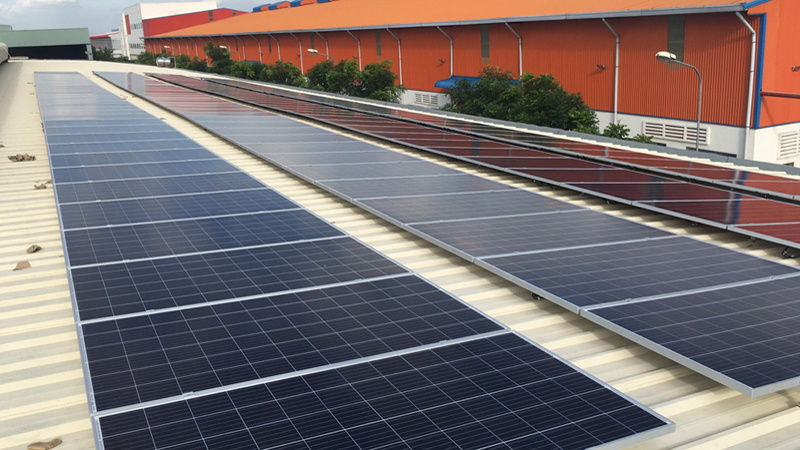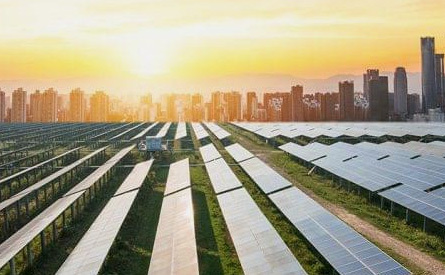Green,Innovation,Intelligent, Sharing
2022-05-05
What is a solar photovoltaic power station? The trend of photovoltaic power plants? Profitability of photovoltaic power generation?
Solar photovoltaic power station operation, namely photovoltaic power generation, refers to the sale of electricity to the State Grid after an enterprise invests in the construction of photovoltaic power stations. Generally speaking, the electricity sales model in China is that the power station sells electricity to the State Grid, and the State Grid transmits electricity to the end users.
At present, solar photovoltaic power stations are mainly divided into concentrated solar photovoltaic power stations and distributed solar photovoltaic power stations. Concentrated solar photovoltaic power plants are generally large in scale and are mainly installed in mountainous areas, water surfaces, deserts and other vast areas. Distributed solar photovoltaic power plants are generally small in scale and flexible in installation, such as the common "photovoltaic roof" in recent years. The continuous upgrading of the "dual carbon" goal by major economies in the world is the main driving force for the development of solar photovoltaic power plants.
According to the statistics of iResearch, except for France, which loves nuclear energy, the carbon emissions of other countries mainly come from the electricity and heat links, which means that if we want to achieve the goal of "carbon neutrality" faster, countries must reduce the carbon emissions in this link emission. In this context, vigorously developing clean energy such as photovoltaics and wind power has become a necessary means to achieve carbon neutrality in the world.
Figure 1: Source of carbon dioxide emission structure of industries in various countries: IrError consulting, 36氪 sorting From the perspective of China’s 2020 power supply structure, clean energy power generation currently accounts for 32% of China’s total power generation, of which photovoltaic and wind power generation account for less than 10% %; in terms of installed capacity, clean energy installed capacity accounted for 43%, of which the total installed capacity of photovoltaic and wind power accounted for 24.31%. In general, the current clean energy power generation in my country is still dominated by hydropower, and the actual penetration rate of photovoltaic and wind power is at a low level.
However, due to the large constraints of hydropower resources and limited room for future installed capacity growth, the task of further replacing thermal power with clean energy falls on the shoulders of photovoltaics and wind energy. Given the instability of photovoltaic and wind power generation, higher installed capacity is required to supplement the gap in thermal power generation. According to iResearch, by 2050, China's total installed photovoltaic capacity will increase by 831% compared with 2020, and the overall scale will reach 2,360gw.
In the face of the huge industrial cake, photovoltaic power plants, as the terminal output link of the industrial chain, have a very clear development logic in the long run.
How to build, invest, operate and maintain a solar photovoltaic power station?
Judging from the solar photovoltaic power generation business data of domestic brand enterprises, the solar photovoltaic power generation business shows a steady growth trend. Take Zhensen Power Co., Ltd., a distributed photovoltaic service enterprise in China, as an example. Zhensen Power was established in 2015. The investment, construction and operation of solar photovoltaic power plants have been strategically laid out, with the focus on providing overall photovoltaic clean energy solutions.
In recent years, Zhensen Electric Power has rapidly invested in the construction of a number of distributed demonstration projects such as Rifeng Management, Xingfa Aluminum, Red Bull, Budweiser, and Ningde Times, FAW-Volkswagen, Foton, Kohler Sanitary Ware, Arrow Sanitary Ware, Midea, Shunwei , LG, Omron and Siemens. The total installed capacity is more than 800MW, the projects are connected to the grid for more than 1100+, and the total annual power generation exceeds 900 million kWh.
Taking a 10MW project as an example, the construction of a solar photovoltaic power station only takes 90 days from the pre-development financing, filing stage, design stage, construction stage and grid connection acceptance.
The investment of solar photovoltaic power plants is divided into two modes: EMC and EPC. Taking the 1MW project model as an example, the minimum investment is 1.1 million yuan, the funds will be recovered in five years, and the total income in 25 years will be 17.584 million yuan. That is to say, the roof of 10,000 square meters is equipped with photovoltaic power plants. Although the annual power generation is about 1.1 million kWh, the income is equivalent to 800,000-1 million.
High-quality and efficient operation and maintenance services should run through the entire life cycle of distributed power station development, filing, access design, financing, construction and operation, so as to maximize the power generation efficiency of photovoltaic power stations.
What is the profit model of solar photovoltaic power plants?
The profit model of solar photovoltaic power plants is relatively simple, mainly from the difference between revenue, cost and expense. Among them, the composition of revenue and cost is as follows:
Income side: The price of electricity sold by the power station to the national grid is called the feed-in price. In the past, due to the high cost of photovoltaic power generation, the on-grid electricity price was inconsistent with the coal-fired electricity price. Therefore, the state gives certain subsidies to the photovoltaic electricity price on the basis of the on-grid electricity price of coal-fired electricity. Therefore, the on-grid price of photovoltaic power plants in operation mainly includes two parts, namely, the on-grid price of photovoltaics = the benchmark price of on-grid coal-fired units + the subsidy price of photovoltaics.
Therefore, the operating income of solar photovoltaic power plants comes from two parts, namely: the electricity sales revenue settled with the State Grid based on the on-grid electricity price benchmark for coal-fired units, and the subsidies given by the state.
Cost side: Solar photovoltaic power plants operate with a large number of assets and basically do not need to input raw materials. Therefore, the operating costs of solar photovoltaic power plants are mainly composed of depreciation of fixed assets. Take solar energy, for example. As of mid-2021, the total investment in solar fixed assets is 33.257 billion yuan, of which 29.438 billion yuan is invested in photovoltaic modules and other power generation equipment, and 1.795 billion yuan in housing construction. In the case of huge investment in fixed assets, the annual depreciation of fixed assets generated by photovoltaic modules and land resources has become the main cost source of enterprises. As shown in the table below, solar depreciation will reach 1.144 billion yuan in 2020, and kWh depreciation will account for 92.77%.
Cost: After the solar photovoltaic power station is completed, there will be stable cash flow. In order to improve the return on equity, some companies will choose debt financing to expand the scale of solar photovoltaic power plants, resulting in a higher asset-liability ratio, which means that financial costs have actually become an important factor in determining the overall profitability of power plants. Profit of solar photovoltaic power station = (baseline price of coal-fired units + photovoltaic subsidy price) * electricity sales - depreciation - financial expenses. Considering that the revenue side of solar photovoltaic power plants is mainly affected by the national subsidy policy and the national grid electricity price, it does not have pricing power in essence. Therefore, if the subsidy effect is not considered, depreciation and financial expenses become the key to determine the operating capacity of solar photovoltaic power plants. , from full cost (cost + fee).
Going back to the PV plant itself, the situation is similar to real estate. Before 2018, the solar photovoltaic power station operation industry was mainly dominated by private enterprises. A large number of private enterprises have relied on debt financing regardless of cost, and wildly increased installed capacity to obtain photovoltaic subsidies. At this stage, photovoltaic power plant enterprises mainly rely on photovoltaic subsidies to make profits.
After the "531 New Deal" in 2018, photovoltaic subsidies have dropped significantly, industry financing has tightened, and subsidies for new solar photovoltaic power plants have been unable to cover high depreciation and financial expenses. At this time, the importance of cost control of solar photovoltaic power plants began to be highlighted. Some private enterprises (such as GCL New Energy) began to sell power plants after 2018 to recover funds and ease debt pressure; on the other hand, central enterprises with low-cost financing have gradually begun to dominate the market. At this stage, the profit logic of solar photovoltaic power station enterprises has also changed from subsidizing to relying mainly on cost reduction and efficiency improvement.
In order to force the upstream links of the photovoltaic industry chain to improve efficiency and reduce costs, the state's photovoltaic subsidy for power plants has been reduced from 0.45 yuan in 2011 to 0 in 2021, realizing the full Internet access. As mentioned above, in the context of affordable Internet access, solar photovoltaic power plant companies that have lost subsidies have officially entered the era of cost war, and companies with the lowest comprehensive cost are most likely to truly stand out.
The trend of solar photovoltaic power plants?
Fundamentally, in the context of carbon neutrality, clean energy has a relatively broad space for development. Among them, considering the objective factors such as low penetration rate and insufficient long-term growth space in resource-constrained hydropower stations, we believe that the long-term growth of the photovoltaic industry is more certain, and the growth of photovoltaic power station operators is also stronger than that of hydropower.
Related News

Contact Information
 sales@esolarstar.com
sales@esolarstar.com
 0086-13929199660
0086-13929199660
 www.hengzhouenergy.com
www.hengzhouenergy.com
 No. 105, building 10, Hekou Wenta Road, southwest Street, Sanshui District, Foshan
No. 105, building 10, Hekou Wenta Road, southwest Street, Sanshui District, Foshan
Copyright © 2022 Guangdong Hengzhou Energy Technology Co., Ltd All Rights Reserved. Powered by:www.300.cn SEO

 Language
Language 







 sales@esolarstar.com
sales@esolarstar.com

 Whatsapp
Whatsapp
 Message
Message